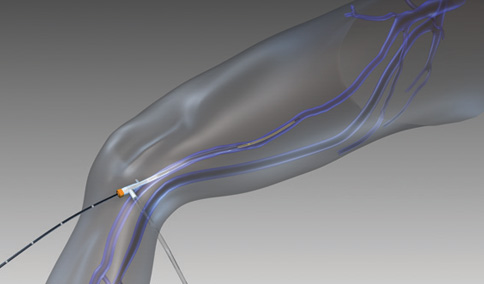Eliminate Your Varicose Veins With Venefit
How It Works
The procedure is performed on an outpatient basis at our clinic. With guidance from an ultrasound, one of our surgeons will position a catheter into the diseased vein through a small opening in the skin. This small tube delivers radiofrequency energy, which heats the vein wall.
As a result, the treatment closes the vein that is causing your condition. Your varicose veins will then significantly decrease in size or completely disappear.
A simple bandage is placed over the insertion site and additional compression is provided to promote healing. Patients who undergo the procedure typically resume normal activities within a day.
Venefit Procedure FAQs
Vein stripping involves the blood vessel being tied off. Your physician will first make a precise surgical cut in your groin then use specialized equipment to thread through the leg vein. The tool is then taken out through another incision made near the knee.
The Venefit procedure is minimally invasive. Your vein is closed using heat delivered by a catheter that is inserted through a small incision below your knee.
Vein stripping is usually performed in an operating room under general anesthesia, while the Venefit procedure is performed at our clinic under local anesthesia.
Using radiofrequency energy in 20-second bursts, the Venefit procedure provides controlled heat to contract the collagen in the vein walls. This causes the blood vessel to collapse and seal. Once a vein is closed, blood flow is redirected to other pathways.
Laser ablation uses heat to contract and seal the affected vein. Peak laser temperatures can reach more than 1334°F (729°C). Patients who have undergone laser ablation treatment may experience more bruising and post-procedure pain compared to those who did the Venefit procedure.
Studies have compared the experience of patients who underwent Venefit and those treated with laser ablation. The findings stated that the Venefit procedure caused less pain, bruising, and other complications. It also proved that Venefit improves the quality of people’s lives faster.
Ontario Health Insurance Plan (OHIP) does not cover Venefit. However, some private insurance companies do. Make sure to consult your insurance provider to determine if the treatment is covered by your plan.
You may apply for financing by Medicard through our website today. Please visit Patient Financing page.
It usually takes one hour to perform.
Venefit is performed under local anesthesia.
The procedure is performed at our Kitchener location.
Patients are usually able to do their daily activities within a few days after the end of their treatment. We also tell our patients to follow the advice we offer them within the first few weeks after the procedure. These include:
-
Stick to a Walking Regimen
-
Avoid Strenuous Activities (i.e. Heavy Lifting)
-
Avoid Standing for a Long Time
-
Wear Your Compression Stockings (For the First Two Weeks at Least)
Most patients report a noticeable improvement in their symptoms within one to two weeks.
Although it is possible to have some discomfort after the treatment, many patients report minimal to no scarring, bruising, tenderness, or swelling.
Patients can expect the appearance of their legs to significantly improve after the procedure. Please note that results depend on the degree and extent of your condition. However, some people have said that they felt immediate relief from the symptoms they were experiencing.
Your surgeon will have a consultation with you to determine if you have any risks that are caused by your condition. They will orient you on the potential complications associated with Venefit. These include:
-
Adjunct Nerve Injury
-
Hematoma
-
Infection
-
Paresthesia (Numbness or Tingling)
-
Phlebitis
-
Pulmonary Embolism
-
Skin Burn
-
Skin Discolouration
-
Thrombosis
-
Vessel Perforation
Patients who have varicose veins and chronic venous insufficiency can be treated with the Venefit procedure. However, your surgeon will still make sure whether you are suited for it.
Age alone is not the main factor in determining if Venefit is right for you. The most important one is the complete ultrasound examination done by your vascular surgeon. Over the years, the procedure has been used to treat people of different ages.
The affected blood vessels become fibrous tissue after the treatment. It will eventually be absorbed into the other surrounding tissue and blood will be rerouted to other veins.

